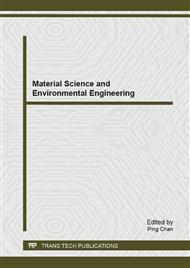p.154
p.158
p.162
p.168
p.172
p.178
p.182
p.187
p.193
Microstructure and Properties of AZ31B Magnesium-LY12 Aluminum Alloys Diffusion-Bonded Joint
Abstract:
In this paper, AZ31B magnesium alloy/LY12 aluminum alloy were bonded together with copper foil as interlayer by vaeuum diffusion bonding technology at different temperature for holding time 60 min and pressure 2.5MPa. Analysis the microstructure of the joint under the condition of 450°C,and the effects of heating temperature on the shear thrength , microhardness and the width of the interface zone were studied. The results showed that under the condition of 450°C in holding time 60 min and pressure 2.5MPa, the microstructure at interface zone of diffusion brazing joint includes α-Mg solid solution, Mg2Cu, Cu2Mg, γ-Cu solid solution, CuAl, CuAl2 and β-Al solid solution. The width of the interface increases with brazing temperature increasing, and the microhardness gradient of interface zone in the side of aluminum alloy is much higher than that in magnesium alloy side. As the welding temperature increases, the shear strength shows an increasing trend at first and then decreases. When the welding process is 460°C keeping for 60 min, welding pressure is 2.5Mpa, the highest shearing strength of the joint can reach 35 MPa.
Info:
Periodical:
Pages:
172-177
Citation:
Online since:
May 2014
Authors:
Keywords:
Price:
Сopyright:
© 2014 Trans Tech Publications Ltd. All Rights Reserved
Share:
Citation:


